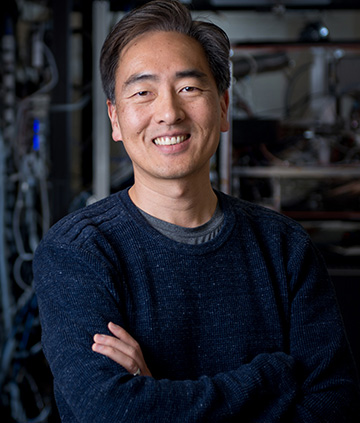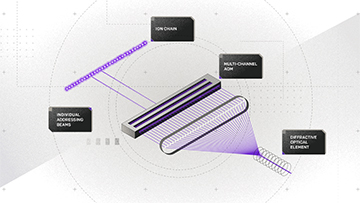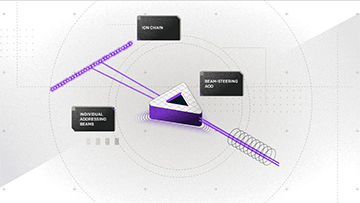![]()
The trapped-ion quantum computer maker IonQ has introduced a new system, Forte, that uses steerable laser beams to improve qubit fidelity and configurability. [Image: IonQ]
IonQ, a US-based maker of trapped-ion quantum computers, has announced its next product generation, dubbed IonQ Forte. The system, according to the company, uses “novel, cutting-edge optics technology” to reduce noise and increase gate fidelity, thereby extending the potential range of user problems the machine can address. IonQ expects to make the system available to a small number of partners and developers this year, with wider rollout in 2023.
A matter of control
Jungsang Kim, the CTO of IonQ, explained to OPN that the company’s development effort is grappling with a fundamental issue that defines the scalability and usefulness of quantum-computing systems.
“For quantum computers to do useful things, as the size of a computer grows, the depth or the size of the circuit you can run has to grow with it,” Kim says. (IonQ boils this down into an application-focused metric it calls “algorithmic qubits”—the maximum number of qubits, N, for which a given system can execute N2 entangled logic-gate operations at sufficiently high fidelity.) “The real challenge is, as you build quantum computers that are bigger, with more qubits, can you also, at the same time, improve the performance and the fidelity and the connectivity, so that we can run deeper and deeper circuits?”

Jungsang Kim, cofounder and CTO of IonQ. [Image: IonQ]
For systems such as IonQ’s—in which the qubits are ytterbium ions trapped and held in place by laser beams—Kim argues that this boils down to issues of control. For trapped-ion systems using hyperfine ground states, he explains, the key time constants for simply storing qubits are long. The thermal relaxation time (t1), for example, “is measured in thousands of years, if not millions of years,” and is a function of how strong a vacuum can be created in the environment hosting the qubits. And the dephasing time (t2) is related to the stability of the clock being used to measure frequency in the system.
What this means in practice, according to Kim, is that “our hyperfine qubits can store information for a very long time”—on the order of hours, which IonQ says has been measured in these qubits. It is when those qubits are put into excited states and coupled for use in logic gates that “the errors come in.” Those errors, Kim maintains, are attributable to things like laser noise, stability of the laser field, control over where the field is delivered and so on. “These are the practical issues that limit our gate fidelity,” he says.
Steerable laser beams
To get around those issues, the new Forte system attempts to improve on previous models by adding additional control to the laser part of the system.
In previous IonQ machines, a separate, fixed laser beam was used to trap and control each qubit. “You had to put the atoms at exactly the right location,” says Kim, “meaning you had to make sure that the spacing of the atom was perfect to match the perfect spacing of the beams.” That put some limits on the fidelity of the logic gates that could be built with such qubits, given the possibility of mismatches and fluctuations between the fixed beam and the qubit position.
In contrast to previous IonQ systems, which used individual fixed laser beams to control trapped-ion qubits (top), the Forte system uses beams steerable via an acousto-optical deflector (bottom). This, according to the company, improves control and gate fidelity, and enhances configurability for specific quantum computation problems. [Images: IonQ]
In Forte, the company has replaced the fixed beams with ones equipped acousto-optical deflectors (AODs). That, says Kim, allows the beams to be steered and pointed to match the qubit position more precisely. In turn, that beam-steering ability “gives you less control errors, which can lead to higher-fidelity performance.”
Toward software-configurable quantum computing
The Forte setup, according to Kim, moves IonQ closer to the company’s ideal of a “software-configurable” quantum computer. That concept is really, he says, about “decoupling the number of qubits in your quantum computer from any of the hardware that defines them.”
In a solid-state quantum device, Kim says, the number of device qubits needs in some sense to be baked into the hardware design. By contrast, in the trapped-ion case, IonQ believes that in principle it doesn’t need to be that way. “The number of qubits in our system is not actually defined,” says Kim, but depends instead on how well they can be controlled.
With the system’s move from fixed to steerable laser beams, “the number of qubits in the system [that can be addressed by the beams] is not really written into the hardware anymore,” says Kim. “I can choose to run Forte with 10 qubits. Or I can choose to run it with 20 qubits; I can choose to run it with 30; probably in the future I could choose to run it with 40 … The configuration can be flexible and can be defined by the software.”
Vendor–customer dialogue
Kim says the Forte system will initially be trialed, in the second half of this year, with a “relatively small number” of customers and partners working on quantum algorithm Q&A who might particularly benefit from early access. Next year the company expects it to become more broadly available, with a larger number of customers including both academic researchers and “the research arms of larger corporations in industry,” according to Kim.
The rollout is part of an ongoing dialogue between IonQ and potential customers to refine the kinds of problems that quantum computers can address better than classical computers, and to tune the emerging crop of quantum machines to those problems.
Kim observes that while a large amount of theoretical work in quantum algorithms has been done in academic settings, the development of practical quantum algorithms—ones solving real-world problems—hasn’t really gotten off of the ground. “For that to happen, you need to do two things,” he says. “You need to give the users a roadmap of how you expect the performance of quantum computers to get better over time. And then you actually have to give them access to real machines where they can start to put together [quantum] methods and test them.” Early-stage users can then come back to quantum-computing vendors with new lists of constraints that need to be overcome to execute specific tasks.
“Every constraint that you learn about becomes an opportunity to innovate,” says Kim. And, he adds, IonQ has been “actively engaging with potential customers” to try to flesh out development priorities to carve out the real-world application space in which quantum computers can clearly outgun classical machines.
According to Kim, IonQ will continue to push its performance hard to make the case for that quantum advantage. “We have to get there as quickly as possible,” he says. “If you don’t get there, you lose not to other [quantum] competition, but to classical computers—the value of quantum computing becomes hard to show … I think, in the next few years, every vendor should be racing to get to that point.”


